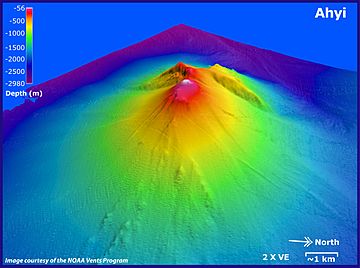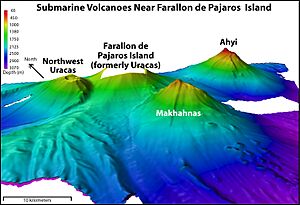Ahyi Seamount facts for kids
Quick facts for kids Ahyi Seamount |
|
|---|---|

Bathymetry map of Ahyi
|
|
| Summit depth | −75 m (−246 ft) |
| Height | ~1,925 m (6,316 ft) |
| Location | |
| Range | Izu–Bonin–Mariana Arc |
| Coordinates | 20°25′12″N 145°01′48″E / 20.42000°N 145.03000°E |
| Country | Northern Mariana Islands, United States |
| Geology | |
| Type | Stratovolcano |
| Last eruption | 2023 |
Ahyi Seamount is an active underwater volcano located in the Northern Mariana Islands. It sits deep in the Northwestern Pacific Ocean. This volcano has erupted three times since the year 2000. Its eruptions were in 2001, 2014, and most recently from 2022 to 2023. Since 2009, Ahyi Seamount has been part of the Marianas Trench Marine National Monument in the United States.
Contents
Where is Ahyi Seamount?
Ahyi is an underwater volcano found in the northern part of the Mariana Arc. The volcano is shaped like a cone, about 12 kilometers (7.5 miles) wide. It rises from a depth of about 2,000 meters (6,560 feet) to just 75 meters (246 feet) below the ocean surface.
You can find Ahyi about 20 kilometers (12 miles) southeast of Farallon de Pajaros. Other nearby underwater mountains include Makhahnas Seamount to the west and Supply Reef to the south.
How Ahyi Was Formed
Ahyi Seamount is part of the Mariana Arc. This arc is a chain of underwater volcanoes. It formed because the Pacific Plate, a huge piece of Earth's crust, is slowly sliding under the Philippine Sea Plate. This process is called subduction.
The Mariana Arc is located west of the Mariana Trench. The Mariana Trench is the deepest part of the world's oceans. East of the arc is the Mariana Trough, which is a basin behind the volcanic chain. Since the 1800s, six out of nine volcanic islands in the Mariana Arc have been active. There are also about 60 underwater mountains in this arc. More than 20 of them have hot water vents, and six have erupted.
What Comes Out of Ahyi?
During the 2014 eruption, scientists collected samples from the plumes coming out of Ahyi. They found high levels of certain gases and elements. These included hydrogen, a special type of helium (Helium-3), carbon dioxide, and iron. This tells us about the materials inside the volcano.
Ahyi's Eruptions
Scientists have noticed volcanic activity in the Ahyi-Supply Reef area since the 1960s. Most of the time, they detect activity using special underwater microphones called hydrophones. They also use seismographs, which measure ground shaking. Sometimes, it's hard to know exactly which underwater mountain is erupting. Other times, people see discolored water on the ocean surface, which is a sign of activity.
Early Eruptions (1960s-1970s)
In 1969, scientists recorded sounds of volcanic explosions from Ahyi. These sounds were picked up by hydrophones and seismic sensors far away. Discolored water was seen between Supply Reef and Ahyi. This activity was similar to what was recorded in 1967. In 1979, a fishing boat reported bubbling water and floating rocks made of sulfur near Ahyi.
The 2014 Eruption
Ahyi erupted in late April 2014. This was an explosive eruption that lasted more than two weeks. It ended a quiet period of 13 years for the volcano. Because the volcano is in a remote area, it was hard to know exactly where the eruption was happening.
Hydrophones in places like Wake Island and seismographs in Guam recorded the explosions. Scientists on a NOAA ship near Farallon de Pajaros, about 20 kilometers (12 miles) from Ahyi, also heard the explosions. They saw orange-yellow bubbles covering parts of the sea surface.
During this time, a NOAA ship was able to collect samples and information. They used a special tool called a multibeam echosounder to map the seafloor. By comparing maps from 2003 and 2014, they found that Ahyi's summit had changed. Its depth increased from 60 meters (197 feet) to 75 meters (246 feet). They also found a new crater, about 95 meters (312 feet) deep, at the top of the volcano.
The 2022-23 Eruption
Ahyi began erupting again on November 18, 2022. The eruption continued until April 26, 2023. At that time, scientists saw no more signs of activity. So, they declared the eruption over. However, on May 23, Ahyi was declared erupting again! Its alert level was raised to "Yellow" and "Advisory."
See Also
- NW Rota-1



